Home > Adults' Programmes > Other > British
Programmes
Programme output for adults
during the 1950's, included the items below. If you have any
information about these or any other programmes of the era, we
would be very grateful to receive it. Just e-mail the address at
the foot of this page and we will try to feature them on their
own pages
'How Do You View?' (1951) - was the first-ever comedy series
on British television and starred Terry Thomas with his famous waistcoats,
mononcle and cigarette holder. Written by Sid Colin and Talbot
Rothwell, the programme opened on Terry in close-up with a very
broad smile saying the classic lines, "How do you view? Are
you frightfully well? You ARE? Oh, good show!".
In the show
Terry was supposed to be a man-about-town complete with butler, a
very decrepit character named Moulton, played by Herbert C.
Walton. Avril Angers was Rosie Lee, 'the girl with the tea',
Janet Brown was Miss Hap, Terry's secretary and Janet's husband
Peter Butterworth, played the chauffeur, Lockit. The running joke
was that, although Terry had a chauffeur, he hadn't a car.
Later in
the show there was another spot where Leslie Mitchell (of
Movietone News fame) used to interview Terry playing some strange
characters such as the Rank Organizations's gong-man, a
broken-down boxer or a Beefeater. The show's musical spot was
filled by guests such as Dickie Valentine, Lita Roza, Adelaide
Hall and once or twice by Jimmy Young. Jimmy played the piano and
was a pop-singer of hits like 'Unchained Melody' and 'Too Young'.
The show was broadcast live.
An Evening's Diversion
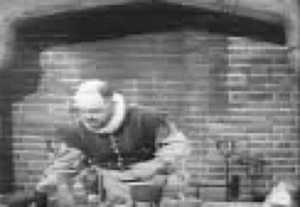
In
1953, our new Elizabethan era brought with it a revived
interest in Good Queen Bess, of Tudor times. So it was
not surprising that the BBC allocated a whole day's
viewing to that far-flung era, when they whisked us back
in time, to the castles and kitchens, of Elizabeth I's
reign.
Even
the announcers, Malcolm, Peters and Hobley, were attired
in Tudor costumes. Mary Malcolm read 'Ye News', which had
been heralded by a dozen or so, appropriately costumed,
village lasses, seen, clinging to floral garlands, and
prancing around a decorated maypole, to the strains of
the BBC TV Newsreel theme.
 Video clip Video clip
Pride
of place, in one grand kitchen, was taken by the BBC's
own television chef: Philip Harben, who - taking time off
from his non-stick frying pan factory, in
Ashton-Under-Lyne; and from his regular weekly TV cook's
slot, on BBC - he donned cross-gartered tights, and
knickerbockers, and talked us through the routine, that
would have prevailed in a kitchen of Shakespeare's
vintage.
He
was assisted by another lovely, 'top drawer' lady: Jeanne
Heale, who - at the time - had taken over from Joan
Gilbert, to present a similar magazine programme, to
Picture Page.
Visit
another site for more
information
|
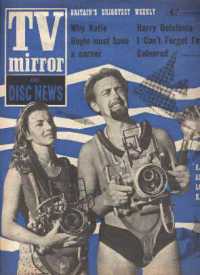 Hans and
Lotte Hass Hans and
Lotte Hass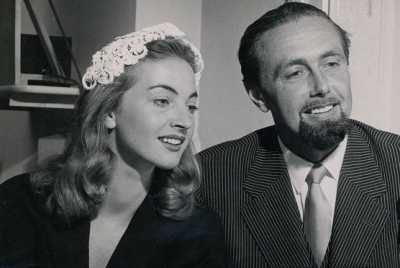
The second half of
the 50s established Armand and Michaela Denis' aquatic
counterparts, Austrian naturalists and divers Hans and
Lotte Hass. Their intrepid underwater films, such as
'Undersea World Of Adventure' were dubbed for English and
German audiences, but they proved more popular in
Britain.
Their first series
in 1956 saw the photogenic aquanauts submerged beneath
the Caribbean, The Aegean and the Red Sea. Then followed
'Undersea World of Adventure' in 1958 and later
'Adventure' (1959-60), which consisted of three series of
documentaries in which Hans and Lotte and a team of
scientists on board the marine research vessel Xarifa
explored underwater life in the Indian Ocean.
Dr. Hans Hass was
the director of the International Institute for Submarine
Research.
|
 1984 1984
An early example
of the power of television drama, Kneale's adaptation of
Orwell's classic parable of totalitarianism garnered both
praise and approbation when transmitted, live, in
December 1954. Questions were asked in Parliament about
the suitability of such strong material for television,
but the controversy was not enough to prevent it being
broadcast a second time - again live - four days later.
Even now, the torture sequences retain their power to
shock and disturb, while the performances, particularly
from Peter
Cushing
and Andre Morell, are striking.
The
entire 1954 version is available on YouTube in 15 parts
|

Audio
clip of the infamous Room 101 torture scene |
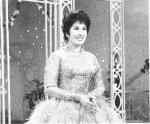 'The Alma
Cogan Show' 'The Alma
Cogan Show'British
TV's First Lady of popular music during the late 50's,
Alma Cogan was top of the bill of almost all the notable
variety shows then running on TV (Max Bygraves
Entertains, Saturday Spectacular, Val Parnell's Startime,
Sunday Night at The London Palladium among others).
|
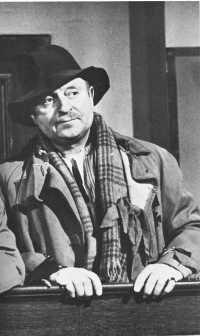 'The Arthur Haynes Show' (1956-66) 'The Arthur Haynes Show' (1956-66)
This
was a comedy favourite for ten years and brought fame and
frustration to to one of Haynes's (left) favourite foils:
Nicholas Parsons; Patricia Hayes, Graham Stark, and
Dermott Kelly were also present. The comedy skits are
fondly remembered. The two most popular routines
consisted of Arthur Haynes's famous tramp ("Up to me
neck in muck and bullets!"), manipulating Parsons's
bewildered officialdom and Haynes's tramp philosophising
on a park bench with colleague Dermott Kelly.
 Arthur Haynes Show audio clip Arthur Haynes Show audio clip
|
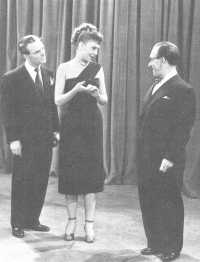 'Before Your Very Eyes' 'Before Your Very Eyes'was a fortnightly comedy
series starring Arthur Askey, aided and abetted by Dickie
Henderson and Diana Decker (right).
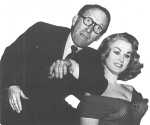 In 1955 Arthur moved over
to ITV and starred in a five part sitcom called 'Love and
Kisses' and in 1956 transferred 'Before Your Very Eyes'
to ITV. In 1955 Arthur moved over
to ITV and starred in a five part sitcom called 'Love and
Kisses' and in 1956 transferred 'Before Your Very Eyes'
to ITV.
'Sabrina' (Norma
Sykes, left) started her TV career with Arthur
Askey.
|
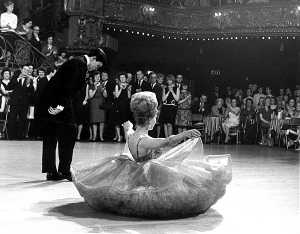 'Come Dancing' (Sept 29 1950) -
was one of television's longest running programmes. It was
originally conceived as a showcase for events from regional
ballrooms, with professionals Syd Perkins and Edna Duffield
offering instructions for viewers at home. It assumed the
familiar dance contest format in 1953. The suits and dresses were
a bit different then. The deviser of the programme was Mecca's
Eric Morley. The comperes in the '50s were McDonald Hobley, Peter
Dimmock, Sylvia Peters, Peter West, Brian Johnston and Peter Haigh.
'Come Dancing' (Sept 29 1950) -
was one of television's longest running programmes. It was
originally conceived as a showcase for events from regional
ballrooms, with professionals Syd Perkins and Edna Duffield
offering instructions for viewers at home. It assumed the
familiar dance contest format in 1953. The suits and dresses were
a bit different then. The deviser of the programme was Mecca's
Eric Morley. The comperes in the '50s were McDonald Hobley, Peter
Dimmock, Sylvia Peters, Peter West, Brian Johnston and Peter Haigh.
'Picture Parade' was also co-presented by Peter
Haigh with the actor Derek Bond and was a weekly review of the
film world. The programme ran for many years and Haigh regularly
interviewed visiting Hollywood stars, including Joan Crawford,
Bob Hope, John Wayne, Tyrone Power and Anna Neagle.
The
beautiful 'Yana' (Pamela Guard) was a frequent visitor to
television who had her own show, in which she sang her seductive,
hit-song: 'Climb Up The Wall'.
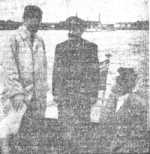 'Nick of The River' (1959) was a series about the Thames River Police.
'Nick' was ex-Detective Inspector D.H.C. Nixon who had written a
book about his 34 year career in the Metropolitan Police, of
which 20 years was spent in the Thames Police, and which became
the inspiration for the series. Incidents in the series were
fictional but the story of his career was authentic. The police
headquarters were at Wapping Police Station and his 'beat'
covered 38 miles of river from Teddington to Dartford Creek. He
organised the detection of crime for the whole of London's
riverside docks. Murder, theft, suicide, smuggling, drug
trafficking.... they all came his way.
'Nick of The River' (1959) was a series about the Thames River Police.
'Nick' was ex-Detective Inspector D.H.C. Nixon who had written a
book about his 34 year career in the Metropolitan Police, of
which 20 years was spent in the Thames Police, and which became
the inspiration for the series. Incidents in the series were
fictional but the story of his career was authentic. The police
headquarters were at Wapping Police Station and his 'beat'
covered 38 miles of river from Teddington to Dartford Creek. He
organised the detection of crime for the whole of London's
riverside docks. Murder, theft, suicide, smuggling, drug
trafficking.... they all came his way.
Starring George Baker as Detective Inspector Nixon with Martin
Wyldeck as 'Tiny' Wainwright and Lane Meddick as Sgt. Flowers. (left to right in picture)
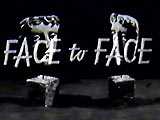 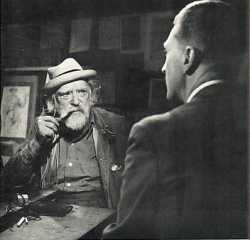 'Face to Face' - The programme of the
incisive and controversial interview brought
internationally famous figures to the BBC television
screen. Tight close-ups were the hallmark of this
programme. They were considered daring at the time, with
the cameras cutting both forehead and chin as they went
in to show the subject, warts and all. Directed by Hugh
Burnett, John Freeman set a standard in the art of
interviewing in depth which has yet to be surpassed. 'Face to Face' - The programme of the
incisive and controversial interview brought
internationally famous figures to the BBC television
screen. Tight close-ups were the hallmark of this
programme. They were considered daring at the time, with
the cameras cutting both forehead and chin as they went
in to show the subject, warts and all. Directed by Hugh
Burnett, John Freeman set a standard in the art of
interviewing in depth which has yet to be surpassed.
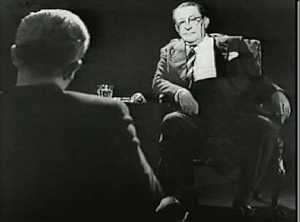 Picture right- John
Freeman interviews Augustus John, the doyen of British
artists Picture right- John
Freeman interviews Augustus John, the doyen of British
artists
Picture left- John Freeman interviws Gilbert Harding
|
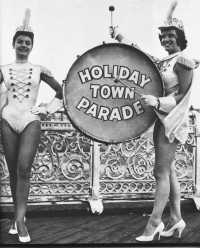 'Holiday Town Parade' - This was a touring variety
show that stopped off at the major seaside resorts in the
UK, and was hosted by MacDonald Hobley. The opening
sequence was unforgettable. Clad in full evening dress,
our man wore a full sized marching bass drum on his chest
which he proceeded to thump as he pronounced - "Make
a date, don't be late, with Holiday Town Parade!".
One of the programme's features was a weekly body
building slot named the Adonis Competition, in which the
chief judge was former Mr. Universe, Arnold Dyson. 'Holiday Town Parade' - This was a touring variety
show that stopped off at the major seaside resorts in the
UK, and was hosted by MacDonald Hobley. The opening
sequence was unforgettable. Clad in full evening dress,
our man wore a full sized marching bass drum on his chest
which he proceeded to thump as he pronounced - "Make
a date, don't be late, with Holiday Town Parade!".
One of the programme's features was a weekly body
building slot named the Adonis Competition, in which the
chief judge was former Mr. Universe, Arnold Dyson.
More
information here'Top Town' - A localised travelling
talent show which originated on radio and then moved over
to television. The producer was Barney Colehan.
|
'The Good Old Days' - began in July 1953 from the City
Varieties Theatre, Leeds, and Leonard Sachs was to become the
celebrated chairman of a show that lasted for thirty years and
featured 2000 artists. The assembled throng not only wore period
clothes like the artists; they were encouraged to join in the
songs too. All the money for their outfits, false beards,
stick-on moustaches and side-whiskers came out of their own
pocket, although some were known to cheat by only wearing costume
from the waist up since only their top halves were visible on
television. The other splendidly individual feature about
"The Good Old Days" was the performance of Leonard
Sachs. No act ever had a bigger build-up as he reeled off a list
of sesquipedalian provincialisms (long words) with the audience
reaching a crescendo of oohs and aahs as Sachs sounded
increasingly constipated. Finally, as the atmosphere reached
fever pitch, he would activate his gavel, shriek, "Your own,
Your very own..." and often introduce an act that nobody had
ever heard of. Each show would close with an exuberant exaltation
from the Chairman to the audience to join in the chorus from 'The
Old Bull and Bush' featuring the whole cast, "but chiefly
yourselves". The programme was produced by Barney Colehan
who also produced 'Have a Go' on the radio
'Monitor' - On Sunday, February 2
1958, another Grace Wyndham Goldie programme went on the
air (see 'Tonight' also). It was called
Monitor and it marked a further step up the ladder of
fame for Huw Wheldon. This programme finally broke the
resistance of the hard core of intellectuals who tended
at that time to equate watching television with paying on
arcade machines. Huw Wheldon showed the work, and in
skilful interviews, revealed the inspiration of a wide
range of artists, musicians, sculptors, poets and people
of the theatre. A film school in its own right, it gave
many directors such as John Schlesinger and Ken Russell a
chance to hone their talents.

Monitor Theme tune
(Marcia from Serenade for Strings by Dag Wiren)
|
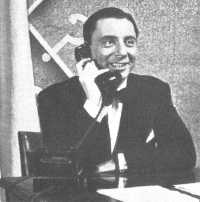 'Kaleidoscope' (1946-53) - began as a fortnightly magazine
programme (every other Friday), presenting such viewer interest
material as Iris Brooke describing antique treasures in
'Collector's Corner'; 'Word Play', a game of charades, played by
members of J. Arthur Rank's Company of Youth (aspiring young film
stars); Leslie Welch, 'The Memory Man'; and the comedy 'Watch
that Faux Pas' with Max Kester as the Lecturer. 'Be Your Own
Detective', a short thriller by Mileson Horton testing the
viewers' powers of observation, started in 1947 with a theme
along similar lines to 'Telecrime'. 'Puzzle Corner' was a slot in Kaleidoscope presented by
Ronnie Waldman (right). Viewers in a pre-announced town
would be invited to display a copy of the Radio Times in their
front room window, if they wished to be considered for the
programme. A house and family being chosen by the advance
production team, the live programme would consist of a quiz,
conducted by Ronnie Waldman by telephone, with the answers from
the participants being heard. The programmes were introduced by
MacDonald Hobley; edited and produced by John Irwin.
'Kaleidoscope' (1946-53) - began as a fortnightly magazine
programme (every other Friday), presenting such viewer interest
material as Iris Brooke describing antique treasures in
'Collector's Corner'; 'Word Play', a game of charades, played by
members of J. Arthur Rank's Company of Youth (aspiring young film
stars); Leslie Welch, 'The Memory Man'; and the comedy 'Watch
that Faux Pas' with Max Kester as the Lecturer. 'Be Your Own
Detective', a short thriller by Mileson Horton testing the
viewers' powers of observation, started in 1947 with a theme
along similar lines to 'Telecrime'. 'Puzzle Corner' was a slot in Kaleidoscope presented by
Ronnie Waldman (right). Viewers in a pre-announced town
would be invited to display a copy of the Radio Times in their
front room window, if they wished to be considered for the
programme. A house and family being chosen by the advance
production team, the live programme would consist of a quiz,
conducted by Ronnie Waldman by telephone, with the answers from
the participants being heard. The programmes were introduced by
MacDonald Hobley; edited and produced by John Irwin.
Eileen
Fowler's
broadcasting career began on the wireless in 1954. In
1956 she established the Keep Fit Association. Before
long she was on televison, surrounded by a gaggle of
girls whose healthy, shining faces, and whose exhibition
of the initials "EF" on their chests,
proclaimed their devotion to the correct ideals. In 1961
the BBC suddenly dispensed with Eileen Fowler's services;
still irrepressible, however, she published Stay Young
Forever. There were also long-playing records to enable
her devotees to persist with her exercises. By the early
Seventies she was back on television with a new
"dance-disco" fitness programme.
|

Video clip |
 'Look' 'Look' British TV's first wildlife series
in 1955. The very first program gave viewers a glimpse of
the nocturnal world of the fox. Presented by naturalist
Peter Scott, the series firmly established the BBC's
filmmakers as innovators of wildlife TV. Eventually axed
in 1969.
View a short
clip here and here
|
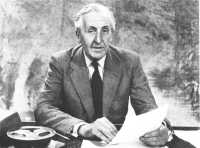 'Men in Battle' (1956) Introduced by General Sir Brian
Horrocks (right) and produced by Huw Wheldon.
'Men in Battle' (1956) Introduced by General Sir Brian
Horrocks (right) and produced by Huw Wheldon.
The Adventures of Brigadier Wellington-Bull (1959) - Starred Alexander Gauge
with Valerie Singleton and Donald Hewlett.
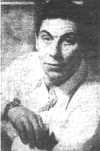 John Slater (left), television's
well known story-teller, invited you to join him at Johnny's Place (1955)
John Slater (left), television's
well known story-teller, invited you to join him at Johnny's Place (1955)
The Lost Planet (1954) Scifi drama serial based on
Angus MacVicar's books. A group of travellers journey to the lost
planet of Hesikos in an atomic spaceship. Starred John Stuart as
Dr Lachlan McKinnon, Geoffrey Lumsden as Lars Bergman, John
Springett as Spike Stranahan, Mary Law as Janet Campbell, Joan
Allen as Madge Smith and Peter Kerr as Jeremy Torant. (6 x 30
minute episodes). Also The Return to the Lost Planet (1954-55).
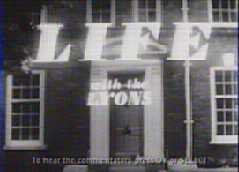 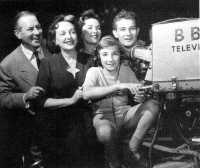 "Life with the Lyons" was a popular domestic
sitcom featuring the real-life family group of Ben Lyon
and Bebe Daniels with their children Barbara and Richard.
Barbara's catch phrase was "I'll die. I'll just
die". They first appeared in a fortnightly series of
shows (following their success on BBC radio with "Hi, Gang!" and
"Life with the Lyons") for BBC TV, before
moving over to ITV in 1957. Scottish actress Molly Weir,
who had been with them on their BBC TV show, also
appeared in the later Associated Rediffusion series as
their housekeeper, Aggie. Their nosey neighbour was
called Florrie and their pet dog was called
"Skeeter". "Life with the Lyons" was a popular domestic
sitcom featuring the real-life family group of Ben Lyon
and Bebe Daniels with their children Barbara and Richard.
Barbara's catch phrase was "I'll die. I'll just
die". They first appeared in a fortnightly series of
shows (following their success on BBC radio with "Hi, Gang!" and
"Life with the Lyons") for BBC TV, before
moving over to ITV in 1957. Scottish actress Molly Weir,
who had been with them on their BBC TV show, also
appeared in the later Associated Rediffusion series as
their housekeeper, Aggie. Their nosey neighbour was
called Florrie and their pet dog was called
"Skeeter". |
'The Dickie Henderson Show' - was one of those somewhat
forgotten "curios of television", based on the deeds of
a sophisticated, if often hard-pressed, song-and-dance man plus
his wife (played in the series by June Laverick), scriptwriter
and accompanist (Lionel Murton) plus various guests. Also 'The Dickie
Henderson Half-Hour'
in which he starred with Anthea Askey playing his wife (1959).
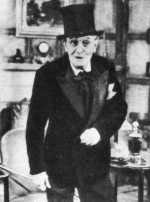
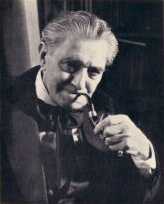 'Bransby Williams' - an elderly, rather threatening,
seated figure (left) who used to do Sunday evening short
readings from Charles Dickens and also Alexander Pope's poetry
and prose straight to camera. Character changes were signalled by
changing the camera's angle and his turning to face it.
'Bransby Williams' - an elderly, rather threatening,
seated figure (left) who used to do Sunday evening short
readings from Charles Dickens and also Alexander Pope's poetry
and prose straight to camera. Character changes were signalled by
changing the camera's angle and his turning to face it.
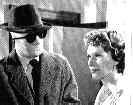 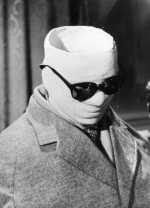 'The Invisible Man' - Dr. Peter Brady
was a scientist conducting experiments regarding
the refraction of light when a laboratory
accident results in his becoming invisible.
Following the authorities' initial investigation,
he is allowed to continue his experiments to
reverse the situation while acting as an unseen
do-gooder for various government and police
departments. Often bandaged up and wearing
sunglasses to give him some recognisable form, he
was supported by his sister, Diane (Lisa Daniely)
and niece Sally (Deborah Watling). Colonel Ward
(Ernest Clarke) was the man from the Ministry.
The series was acclaimed for its special effects
at the time. These included a self-smoking
cigarette and a self drinking wineglass. The part
of Brady was anonymous in the credits. (Tim
Turner supplied the voice). 'The Invisible Man' - Dr. Peter Brady
was a scientist conducting experiments regarding
the refraction of light when a laboratory
accident results in his becoming invisible.
Following the authorities' initial investigation,
he is allowed to continue his experiments to
reverse the situation while acting as an unseen
do-gooder for various government and police
departments. Often bandaged up and wearing
sunglasses to give him some recognisable form, he
was supported by his sister, Diane (Lisa Daniely)
and niece Sally (Deborah Watling). Colonel Ward
(Ernest Clarke) was the man from the Ministry.
The series was acclaimed for its special effects
at the time. These included a self-smoking
cigarette and a self drinking wineglass. The part
of Brady was anonymous in the credits. (Tim
Turner supplied the voice).
More Invisible Man information
|
|
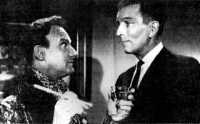 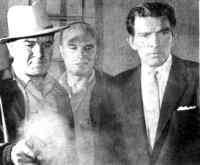 'The Third Man' (1959-60) 'The Third Man' (1959-60)
Michael
Rennie starred as Harry Lime, a wealth
businessman-adventurer who globetrotted from one
international intrigue to another on behalf of the
underdog. He was assisted by his personal secretary
Bradford Webster (played by Jonathan Harris).
(Anglo-American series)
 Third Man theme Third Man theme
|
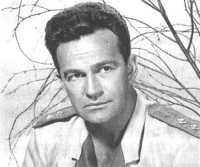 'African Patrol' (1958) Policing the East African
territory of Kenya was the theme and setting for this
action-adventure series. John Bentley (pictured right)
played Patrol-Inspector Paul Derek, a safari sheriff and was
later to appear in "Crossroads". (39 episodes)
'African Patrol' (1958) Policing the East African
territory of Kenya was the theme and setting for this
action-adventure series. John Bentley (pictured right)
played Patrol-Inspector Paul Derek, a safari sheriff and was
later to appear in "Crossroads". (39 episodes)
 African Patrol opening theme
African Patrol opening theme
'The New Adventures of Martin Kane, Private Eye' (aka Martin Kane, Private
Investigator) (1957-58) Starred William Gargan as Kane with Brian
Reece as Superintendent Page. A Towers of London Production for
ABC TV, produced by Harry Alan Towers. (39x30-minute episodes)
Link for more
information about Martin Kane
'Man From Interpol' (1959-60) starred Richard Wyler as
Interpol Agent Anthony Smith with John Longdon as Superintendent
Mercer.
The supporting cast included John Serret as the French Police
Chief and Peter Allenby as Ricardi of the Italian Carabineri.
The series was based on cases of an Interpol Agent assigned to
Scotland Yard.
In the U.S. some episodes of "Man From Interpol" were
shown on
NBC's "Detectives Diary" series (circa 1961).
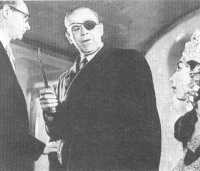 Click on the picture for video clip
|
'Colonel
March of Scotland Yard' (1956-7) The series was
based on the Carter Dickson collection of short stories, The
Department of Queer Complaints, published in 1940.
It starred Boris
Karloff as
the urbane, eye-patched sleuth who worked for D-3 and
whose mystery-solving ranged from the unnatural to the
supernatural. On other occasions, supposedly impossible
crimes landed on his desk (including a murder in a sealed
compression chamber where no-one could have reached the
victim). March even confronted The Abominable Snowman in
one episode. However he always found the solution. Ewan
Roberts and Richard Wattis supported. (26 episodes). |
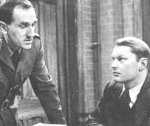 'Spycatcher' was based on the published wartime
experiences of Allied counter-espionage wizard Lt.-Col. Oreste
Pinto. The theme of the series was that with the German
occupation of Europe there was a steady flow of refugees into
Britain, all of whom had to be screened by Col. Pinto and his
team of interrogators to prevent the infiltration of enemy spies.
Bernard Archard played Pinto as the relentless spycatcher who,
generally through a bit of verbal psychological warfare, usually
got his man; in one particular episode forcing a confession out
of a spy by the simple means of using Hitler's portrait as a
dartboard!
'Spycatcher' was based on the published wartime
experiences of Allied counter-espionage wizard Lt.-Col. Oreste
Pinto. The theme of the series was that with the German
occupation of Europe there was a steady flow of refugees into
Britain, all of whom had to be screened by Col. Pinto and his
team of interrogators to prevent the infiltration of enemy spies.
Bernard Archard played Pinto as the relentless spycatcher who,
generally through a bit of verbal psychological warfare, usually
got his man; in one particular episode forcing a confession out
of a spy by the simple means of using Hitler's portrait as a
dartboard!
 Spycatcher Theme
Spycatcher Theme
O.S.S (1957-58)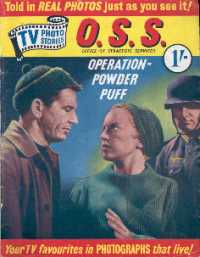
Stories
from the files of America's Office of Strategic Services
(the wartime predecessor of the CIA) were the basis for
this Second World War cloak-and-dagger adventure. The
Anglo-American series, based at the National Studios at
Elstree under producer Jules Buck, featured Ron Randell
as OSS agent Major Frank Hawthorne who undertook
clandestine missions into occupied Europe for purposes of
sabotage, rescue, contact, and information. Filmed in
moody, night-time black and white (several episodes were
directed by ace film noir maker Robert Siodmak), in
England and France, each of the stories dramatized
apparently had a basis in actual Second World War
history; executive producer on the programme was Colonel
William Eliscu, one-time aide to real-life OSS Chief
General 'Wild Bill' Donoran. Lionel Murton was
Hawthorne's Chief back at headquarters and Robert Gallico
played their assistant, Sgt. O'Brien. In all 26 ×
half-hour episodes were produced.
As
each episode opened the theme tune played and a voiceover
was heard as the figure of a parachutist fell from a
plane:
“This
is an agent of the OSS, en-route to a mission behind
enemy lines.
One of the nameless, faceless army, who fought the lonely
war - the silent war.
To this day, stories untold of heroes unknown.
This is a mission from the annals of the Office of
Strategic Services -The OSS.”
 O.S.S Theme O.S.S Theme
|
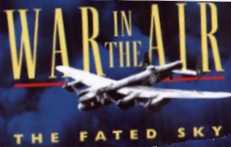 'War in the Air' (1954) - A classic BBC documentary
series from the 1950s chronicling the air war in World War Two.
In its time, it was regarded as the definitive analysis and for
twenty years it was part of the required viewing for all new RAF
recruits.
'War in the Air' (1954) - A classic BBC documentary
series from the 1950s chronicling the air war in World War Two.
In its time, it was regarded as the definitive analysis and for
twenty years it was part of the required viewing for all new RAF
recruits.
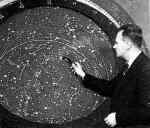 'The Sky at Night' (1957)
'The Sky at Night' (1957)
Introduced
by Patrick Moore. Began 6 months before Sputnik was launched.
With his terse diction and generally windswept appearance Moore
has explored, charted, explained and analysed the great
astronomical events of the past half century for the benefit of
the late-night TV viewer.
'Shadow Squad' (1957-59)
Detective
Vic Steele (Rex Garner) had resigned from the Flying Squad, tired
of the rules and regulations which hampered his work. He set up
his own agency, assisted by Londoner Ginger Smart (George Moon),
and named it Shadow Squad. Often calling on the help of their
cleaner, Mrs. Moggs (Kathleen Boutall), the pair investigated all
manner of intriguing crimes. After 26 episodes, Steele was
mysteriously written out and the agency was handed over to
another ex-cop, Don Carter (Peter Williams). Steele was sent off
on a mission to Australia, never to return.
It was the Carter/Smart combination that made this twice weekly
show a success, although a spin-off entitled Skyport (see below),
featuring Ginger as an airport security man, failed to 'take-off'
and lasted only a year.
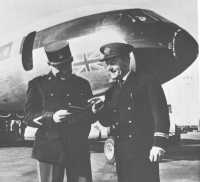 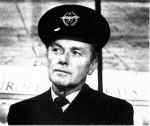 'Skyport' (1959-60) 'Skyport' (1959-60)
Presented
half-hour dramas set against the background of large
airport. George Moon (right) starred as an
airport security man supported by Lisa Gastoni, Gerald
Harper and Barry Foster. 52 episodes.
|
'The Trollenberg Terror' was a Saturday evening serial
shown in 1956 and featured Ronan O'Casey.
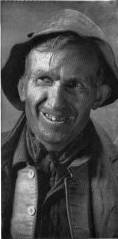 'Nathaniel Titlark' (1956) 'Nathaniel Titlark' (1956)
The first TV sitcom role for the great stage and film
actor Bernard Miles (left). It was based on an earthy
country character whom he created, Nathaniel Titlark,
described as 'a rare combination of poet, peasant,
poacher, bird-watcher and connoisseur of fine beer'.
The episodes were set in a village in the Chiltern Hills
(north-west of London), allowing Miles ample scope to
exercise a country dialect.
Bernard Miles - Nathaniel Titlark
Megs Jenkins - Jessie Titlark (series 1)
Maureen Pryor - Jessie Titlark (series 2) |
| 'Your Life In Their Hands' (1958) The BBC took the
revolutionary step of transporting their cameras into a
real operating-theatre to witness surgeons at work. The
series ran for six years and was made with the full
co-operation of the staff in the hospitals that were
visited and the vast majority of doctors supported the
programme, saying it provided a valuable service in
dispelling fears about surgery. However, The British
Medical Association strongly attacked the programme and,
in an article in the British Medical Journal, it
accused the BBC of 'pandering to the morbid' and called
the first programme, which showed six polio patients
being kept alive by artificial breathing pumps,
'deplorable'. It was concerned that the series would
increase people's worries about their own health. The BMA
concluded: 'We hope that in its search for realism, the
BBC will not find itself telecasting a death on the
table. But even if it is not provided with this
sensation, the viewing public should be in for a real
blood-curdling treat'.
(Thank goodness it
was only in monochrome then!)
|
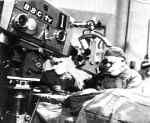 |
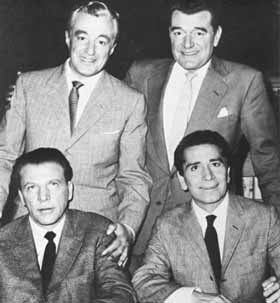 The Four
Just Men (1959-60), inspired by
characters in Edgar Wallace's 1905
novel and produced by Sapphire Films Ltd for ITC,
starred Jack Hawkins as Ben Manfred MP based in London,
Dan Dailey as Tim Collier, a journalist based in Paris,
Richard Conte as Jeff Ryder, a lawyer in New York, and
Vittorio de Sica as Ricco Poccari, a prominent hotel
owner in Rome. The Four
Just Men (1959-60), inspired by
characters in Edgar Wallace's 1905
novel and produced by Sapphire Films Ltd for ITC,
starred Jack Hawkins as Ben Manfred MP based in London,
Dan Dailey as Tim Collier, a journalist based in Paris,
Richard Conte as Jeff Ryder, a lawyer in New York, and
Vittorio de Sica as Ricco Poccari, a prominent hotel
owner in Rome.
Also appearing on a semi-regular basis were Honor
Blackman in the Dailey episodes, June Thorburn in the
Conte episodes, Lisa Gastoni in the de Sica episodes, and
Andrew Keir in the Hawkins episodes.
The
first episode (Battle of the Bridge) involved all
the stars, showing how they were re-united by their
former WW2 commander to band together to right
injustice wherever they found it.
The following episodes allowed each of the Just
Men to star in their own stories, although there were
uncredited cameo appearances. For example, Dan Dailey
appears in the Jack Hawkins episode Village of Shame.
No case was too big or too small for the Four Just Men to
handle, ranging from juvenile problems to international
crime and political intrigue.
There
were 39 black-and-white episodes, using locations in
Britain, France and Italy.
Episode guide
|
Top of Page

If
you have any comments or further information of interest, please
e-mail
webmaster@whirligig-tv.co.uk


 Hans and
Lotte Hass
Hans and
Lotte Hass
 1984
1984
 'The Alma
Cogan Show'
'The Alma
Cogan Show' '
' '
' In 1955 Arthur moved over
to ITV and starred in a five part sitcom called 'Love and
Kisses' and in 1956 transferred 'Before Your Very Eyes'
to ITV.
In 1955 Arthur moved over
to ITV and starred in a five part sitcom called 'Love and
Kisses' and in 1956 transferred 'Before Your Very Eyes'
to ITV. '
'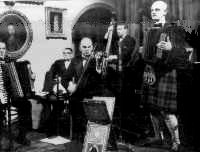
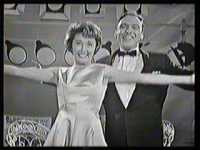 '
' '
'
 '
' Picture right- John
Freeman interviews Augustus John, the doyen of British
artists
Picture right- John
Freeman interviews Augustus John, the doyen of British
artists '
' '
'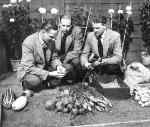 '
' '
' 'Men in Battle' (1956) Introduced by General Sir Brian
Horrocks (right) and produced by Huw Wheldon.
'Men in Battle' (1956) Introduced by General Sir Brian
Horrocks (right) and produced by Huw Wheldon.  John Slater (left), television's
well known story-teller, invited you to join him at
John Slater (left), television's
well known story-teller, invited you to join him at 
 "
"
 'Bransby Williams' - an elderly, rather threatening,
seated figure (left) who used to do Sunday evening short
readings from Charles Dickens and also Alexander Pope's poetry
and prose straight to camera. Character changes were signalled by
changing the camera's angle and his turning to face it.
'Bransby Williams' - an elderly, rather threatening,
seated figure (left) who used to do Sunday evening short
readings from Charles Dickens and also Alexander Pope's poetry
and prose straight to camera. Character changes were signalled by
changing the camera's angle and his turning to face it. 
 '
'
 '
' '
'
 '
'
 '
' '
'
 '
' '
'

